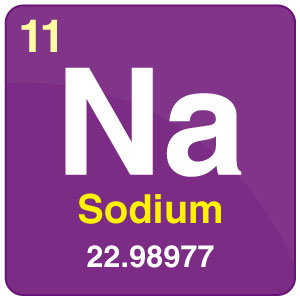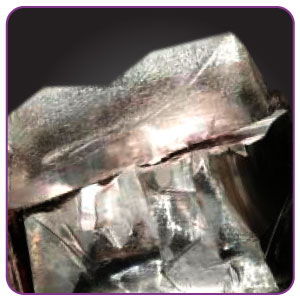Sodium

| Symbol | Na |
| Atomic Number | 11 |
| Atomic Mass | 22.990 |
| Discovered by | Sodium was discovered by Humphry Davy |

Physical Properties of Sodium
- Sodium has a strong metallic lustre. In colour, it is very analogous to silver.
- It is soft at common temperatures that it can be shaped into leaves by the pressure of the fingers.
- Sodium compounds tarnish rapidly on exposure to the air, though less rapidly than potassium.
- Sodium reacts with the oxygen in the air to form sodium oxide which then reacts with water vapour in the air to give sodium hydroxide film.
Chemical Properties of Sodium
| Group | 1 | Melting point | 97.794°C, 208.029°F, 370.944 K |
| Period | 3 | Boiling point | 882.940°C, 1621.292°F, 1156.090 K |
| Block | s | Density (g cm−3) | 0.97 |
| Atomic number | 11 | Relative atomic mass | 22.990 |
| State at 20°C | Gas | Key isotopes | 23Na |
| Electron configuration | [Ne] 3s1 | CAS number | 7440-23-5 |
| ChemSpider ID | 4514534 | ChemSpider is a free chemical structure database | |
What is Sodium?
- Sodium is a member of the alkali metal family with lithium and potassium. Being one of the two elements in our table salt is its the biggest claim to fame.
- Sodium chloride is obtained by the reaction of sodium with chlorine. It is also used as a salt in fertilizers.
- Sodium is a reactive, soft metal with a low melting point and most important of all alkaline metals from the commercial point of view. Sodium reacts rapidly with water, snow, and ice to produce sodium hydroxide.
- When metallic sodium is exposed to air, it loses its silver appearance and develops an opaque grey colour layer which is a coating of sodium oxide. Sodium does not react with nitrogen even at very high temperatures but reacts with ammonia to form sodium amide.
- Sodium reacts with hydrogen above 200ºC to form sodium hydride. It also reacts with various metallic halides to form sodium chloride and the metal.
- With an atomic number of 11, it is represented by the symbol Na in the Periodic table.
Uses of Sodium
- It is also used in improving the structure of certain alloys; soaps, the purification of molten metals and sodium vapour lamps.
- Sodium is a component of sodium chloride, which is a very important compound found in the living environment.
- Sodium is important in the manufacturing of organic compounds and in making esters.
- Solid sodium carbonate is required in making glass.
Also, Read:
Sodium Borohydride
Titration of Hydrochloric Acid against Standard Sodium Carbonate
Titration of Oxalic Acid against Sodium Hydroxide
|
Related Elements |
|||
| Hydrogen | Nickel | Neon | Potassium |
| Helium | Copper | Cobalt | Calcium |
| Lithium | Zinc | Magnesium | Scandium |
| Beryllium | Gallium | Aluminium | Titanium |
| Boron | Germanium | Silicon | Vanadium |
| Carbon | Arsenic | Phosphorus | Chromium |
| Nitrogen | Selenium | Sulfur | Manganese |
| Oxygen | Bromine | Chlorine | Iron |
| Fluorine | Krypton | Argon | |
Frequently Asked Questions – FAQs
Q1
Why is sodium stored under kerosene?
Sodium is a very reactive metal which reacts with oxygen and moisture in the air if kept open. To avoid external contact, sodium is stored in kerosene.
Q2
Why sodium is highly reactive?
Sodium belongs to group 1 which is called alkali metal. Having one electron in the outermost shell causes low ionisation energy. Easy removal of electrons makes sodium highly reactive.
Q3
Why is sodium soft?
Sodium has weak metallic bonding in it. Delocalised electrons are not located over a single atom but over a number of atoms. The weak bonding results in the softness of the metal.

it was a well explained